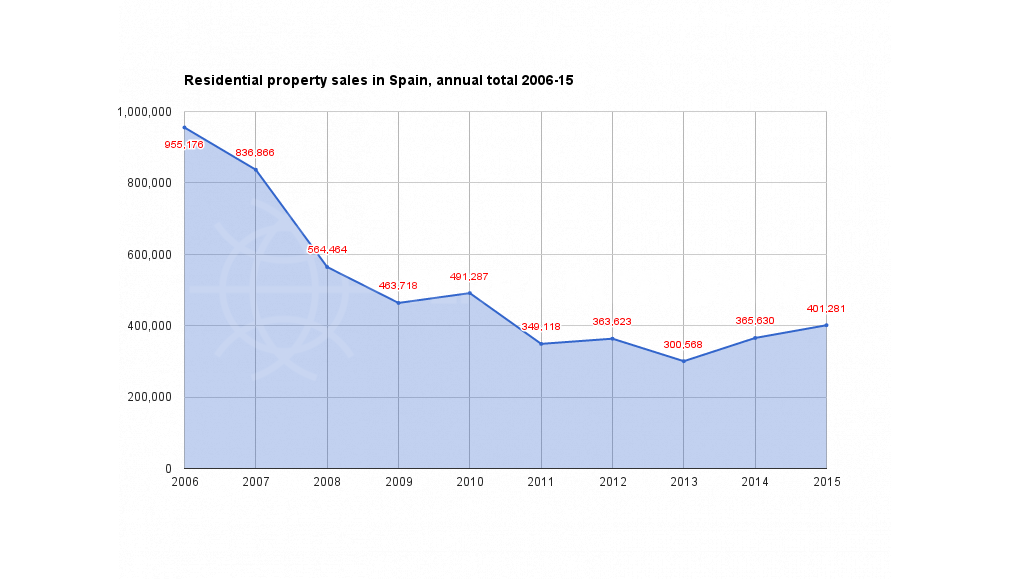Property News
Spain and Costa del Sol residential property market report 2015
Terra Meridiana has put together an overview of the national and Costa del Sol residential real-estate marketplaces, drawing on data from official sources over a 10-year period, to provide buyers and sellers with a guide to where the market is coming from and our view of where it may be going.
Looking back over the last decade, the market for residential property in Spain has been on a rollercoaster ride, from the record all-time highs – in terms of volume of sales and average prices per square metre – of the mid-2000s to the bottom of the market at the close of 2013, before slowly but steadily starting to recover during the last couple of years.
Using data sourced from Notaries , Registrars , the National Statistics Institute (Instituto Nacional de Estadística, INE), and the Ministry of Public Works (Ministerio de Fomento), we have tracked key data over 10 years to quantify changes, identify trends, and enable a better understanding of the Spanish and local property markets.
After seven years of contraction, housing sales have risen for the last two years
Over the last decade, the total number of residential properties sold annually in Spain declined from an all-time high of 955,176 in 2006 to 300,568 in 2013, before recovering to reach 401,281 in 2015. This represents an absolute drop of 68.5% in the volume of national sales over a seven-year period from the top of the market, but an increase of 33.5% in the last two years.
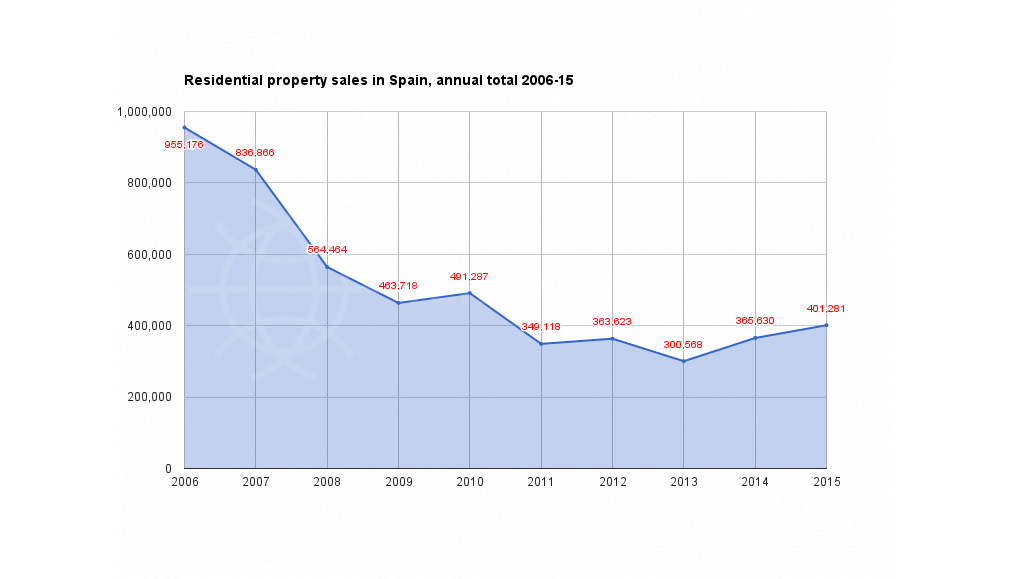
Terra Meridiana’s view: Spanish housing sales bottomed out in Q3 2013 and the number of properties sold nationwide has been increasing on a quarterly basis since then, as investor confidence has recovered, more financing has become available, and real estate in Spain is, once again, seen as a safe and good-value investment.
On the Costa del Sol, sales have recovered to pre-crisis property boom levels
The main markets we cover on the Costa del Sol – Marbella, Estepona, Benahavís – all registered declines in the total number of residential property sales over the same 10-year period, but, unlike the provincial capital of Malaga, all three had recovered to 2006 levels by the end of 2015.
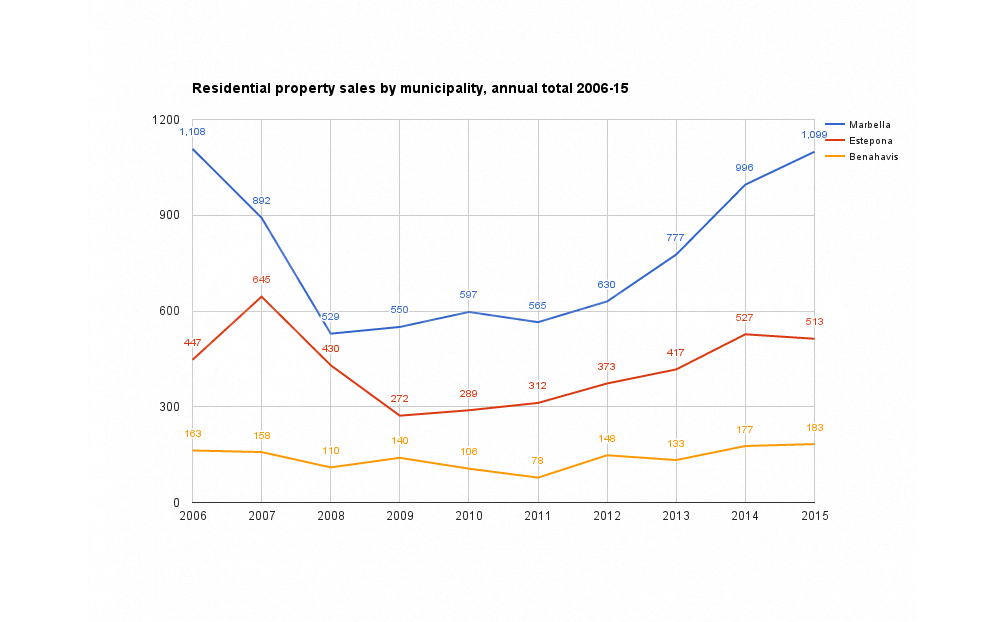
Marbella – Sales declined from 4,432 properties in 2006 to 2,116 in 2008, a 52% drop, but have been rising year-on-year since 2009 to reach a total of 4,396 sold in 2015.
Estepona – After hitting a peak of 2,581 properties sold in 2007, a 44% increase over 2006, sales dropped by 58% to 1,086 in 2009, before recovering positive growth to 2015, when 2,052 homes found new owners, an increase of 88.9% the last six years.
Benahavís – A much smaller market with high demand from affluent overseas buyers, sales dropped by over half (52%) from 2006 to the bottom of the market in 2011, but have since rebounded to grow by 135% in just four years to the end of 2015.
Terra Meridiana’s view: Demand for the premium locations we serve on the Costa del Sol faltered even before the worst of the financial crisis hit the rest of Spain, but sustained interest from overseas buyers, many of whom do not rely on banks to fund purchases, have seen markets not suffer as much as elsewhere around the country and recover much faster to return to the kind of volumes seen a decade ago.
The market composition changed drastically, with a huge slide in new-build sales
In 2006, the number of resale properties sold comfortably exceeded new homes (530,832 compared to 377,156, equivalent to 58.5% vs. 31.5% of the total market). The number of resale homes sold fell the following year by more than 20%, while new home sales remained strong and, by 2008, new home sales outstripped resales by a similar margin (291,479 vs. 218,402, equivalent to 58.1% vs. 31.9%).
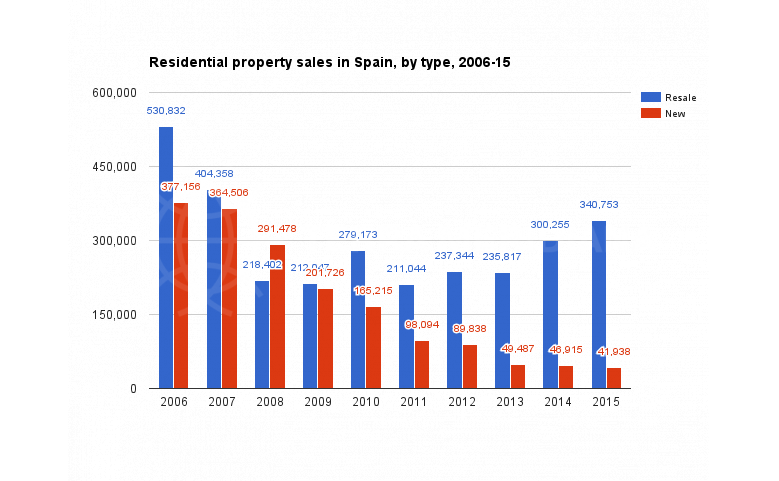
Since then, the number of new homes sold across Spain has fallen precipitously, accounting for just 11% of the overall housing market in 2015. In Andalusia and the province of Malaga, the market followed a similar trend: the number of new homes sold in Andalusia from 2007-15 dropped by 89.3%, while the provincial decline was 86.7%.
Terra Meridiana’s view: Following a construction boom in the early to mid-2000s, Spain built up a large stock of homes, many in less desirable, green-field locations around larger cities. As a result of the credit crunch and the constraints of mortgage availability for local buyers, sales of new-build properties plummeted nationwide. Resale properties remained more sought-after, especially those located in consolidated areas in smaller towns and cities on the Costa del Sol, where the share of overseas buyers has consistently been higher.
Housing prices dropped sharply from 2008-13, but have risen over the last two years
After posting a 5.7% increase in 2007, housing prices across Spain began to slide year-on-year from 2008 until 2013, registering a cumulative drop of 45% over the six-year period. The period from 2011-13 represented the greatest falls, with the value of properties declining by well over 10% annually in both 2011 and 2012. However, prices rallied for the first time in 2014, by just 1.8%, but rose by 4.2% in 2015.
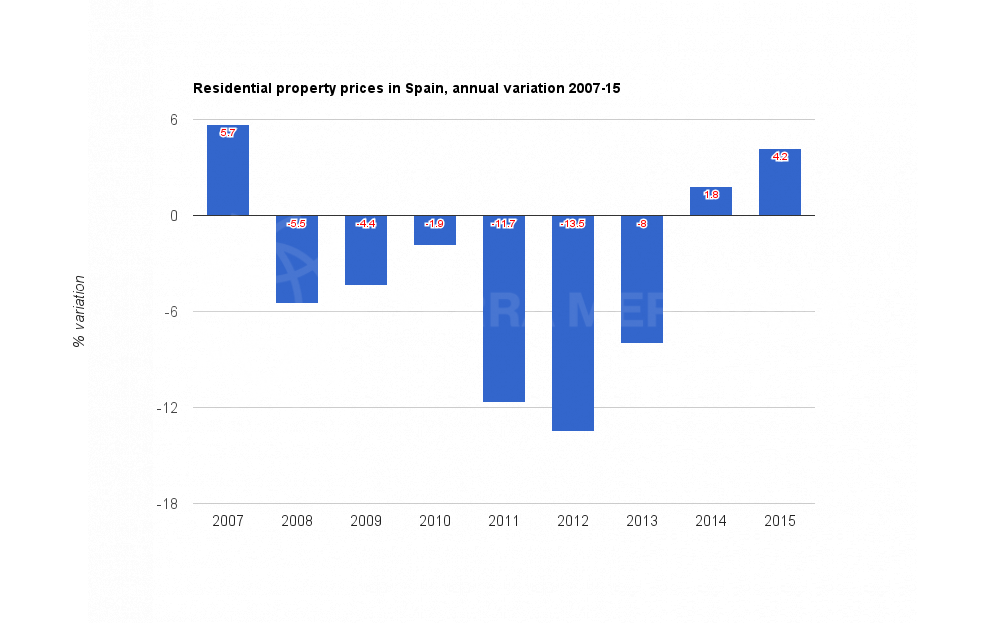
Terra Meridiana’s view: After more than a decade of unsustainable double-digit growth in house prices across the country, the bubble had to burst as Spain had both priced itself out of the international market for foreign buyers, who could purchase cheaper properties elsewhere, and become too expensive for local salaries. As a result, the significant readjustment in housing prices over the last few years has made homes in Spain much more affordable for all kinds of buyers. Spanish property now looks increasingly like a good value investment, compared to competing markets.
The mortgage marketplace is growing again, after contraction due to the credit crunch
The number of mortgages granted in Spain fell by more than three-quarters (76.1%, from 836,419 to 199,703) in the six years from 2008-13. Since 2004, the national total has risen by 22.7%, to 245,120 in 2015, with most of the growth occurring during the last year.
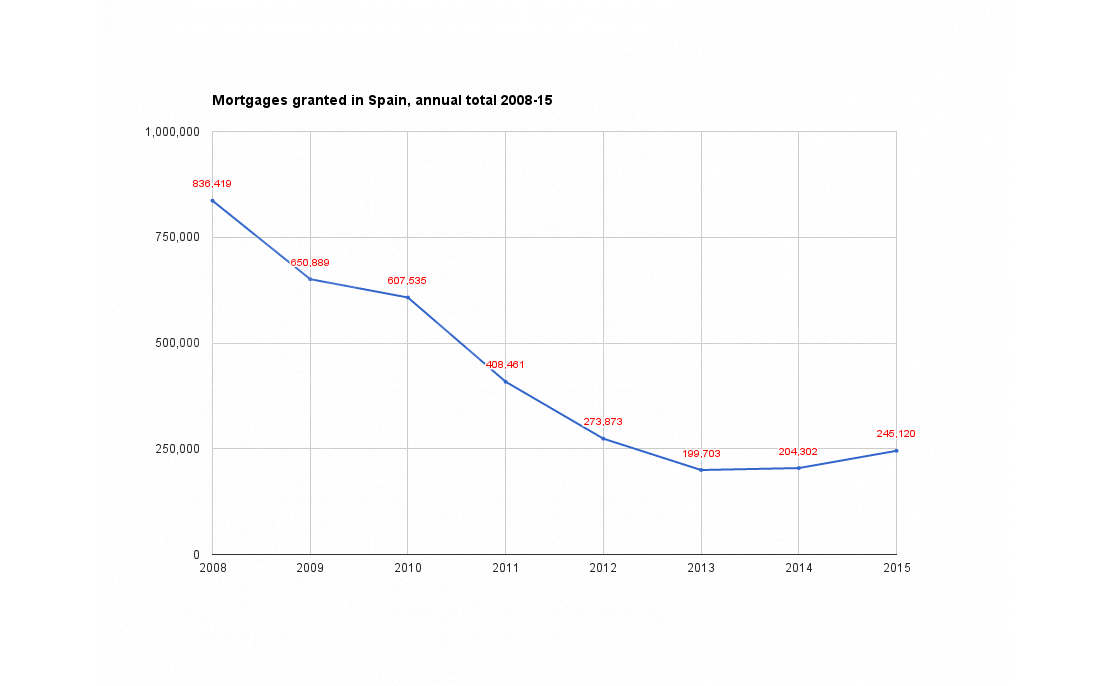
Terra Meridiana’s view: The consequences of the collapse of the construction and house-buying bubble hit Spain’s banks hard. Many were seriously overleveraged, swamped by bad loan portfolios, and suffering from severe cash reserve problems. A wave of bailouts, closures and mergers followed, propped up by public funds. Today, Spain’s financial sector is in much more robust health, with the major lenders all passing EU stress tests with flying colours. Credit has begun to flow again, although we are unlikely to see a return to the risky lending practices of the past.
The number of foreign buyers has recovered and continues to rise nationwide
The share of foreign buyers in the Spanish market declined to less than half of its 2006 total by 2009 (by 52.7%, from 8.94% to 4.24%), but has risen steadily since then to reach 13.24% overall in 2015.
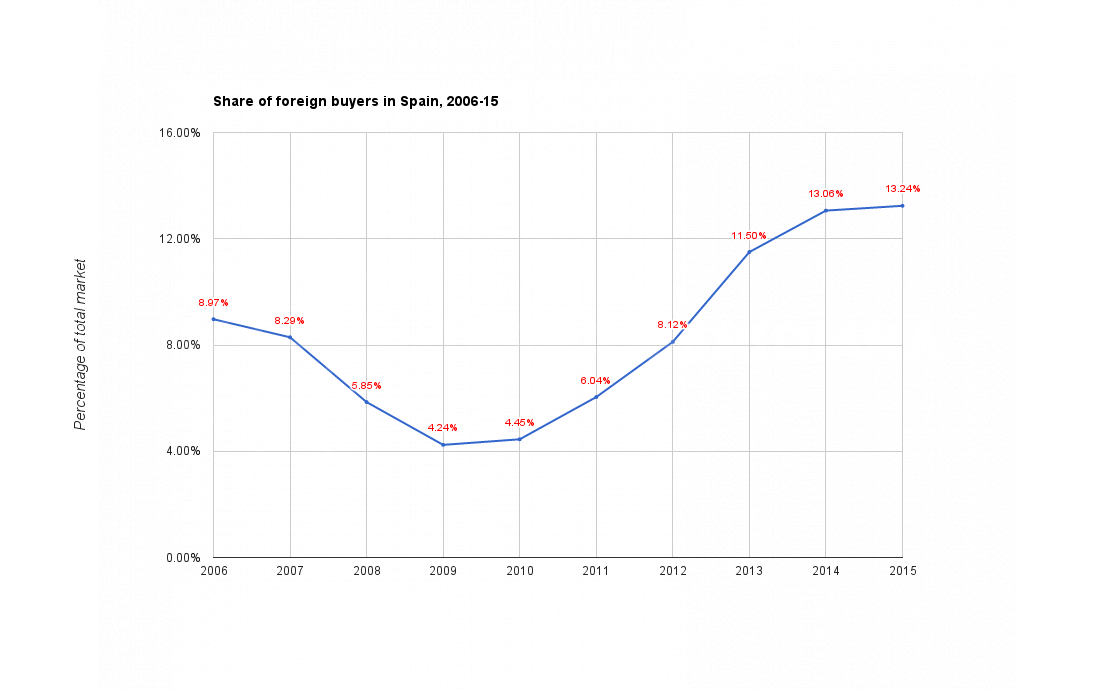
Terra Meridiana’s view: Foreign buyers were among the first to get cold feet, following the bursting of Spain’s housing bubble, as, unlike local purchasers, they were simply able to look at other places around the world to invest in property. However, since 2010, the share of overseas buyers has increased year-on-year to more than three times its lowest mark over the last five years alone, highlighting the return of foreign confidence in and demand for property in Spain.
British and EU buyers continue to make up most of the Costa del Sol market
Data for Andalusia as a whole reveals the British to be the leading nationality in terms of property buying, accounting for 21% of all purchases by residents and 36% of those by non-residents in 2016, accounting for far higher shares of the overseas marketplace than the next nationality. The overall number of transactions by foreign buyers dropped from 2006-09, but has risen since then, with the British leading the Scandinavians, French and Germans in the number of homes bought. Year-on-year, the number of British buyers nationwide rose by 35% from 2014-15, more than any other nationality, while the Russian market fell by 47%.
Terra Meridiana’s view: The strength of sterling, which increased in value against the euro from 2009-2015, has helped make Spain the first choice for Britons buying property abroad. While other euro-currency markets also registered growth during the same period, the growth of the British market share of all overseas buyers was significantly greater. At the same time, the 2014 ruble crisis in Russia has caused a sharp downturn in what was one of the fastest-growing national markets.
By Adam Neale | Property News | May 31st, 2016
